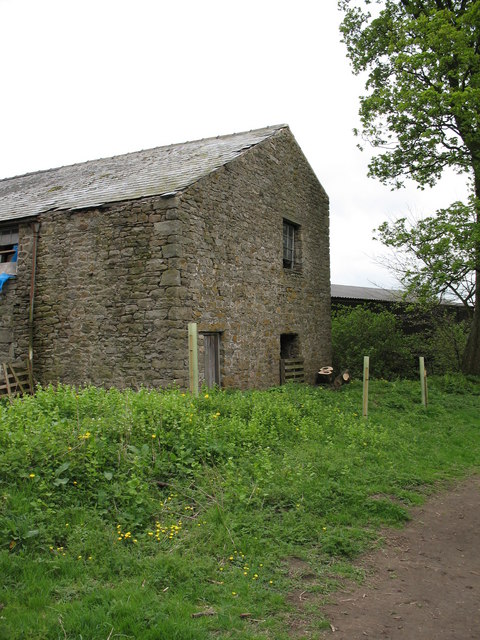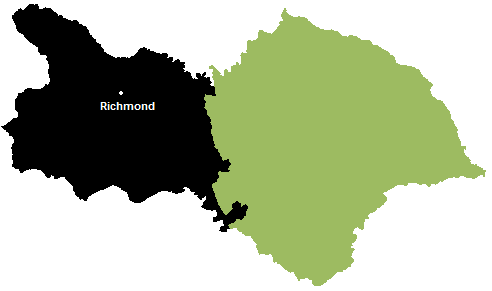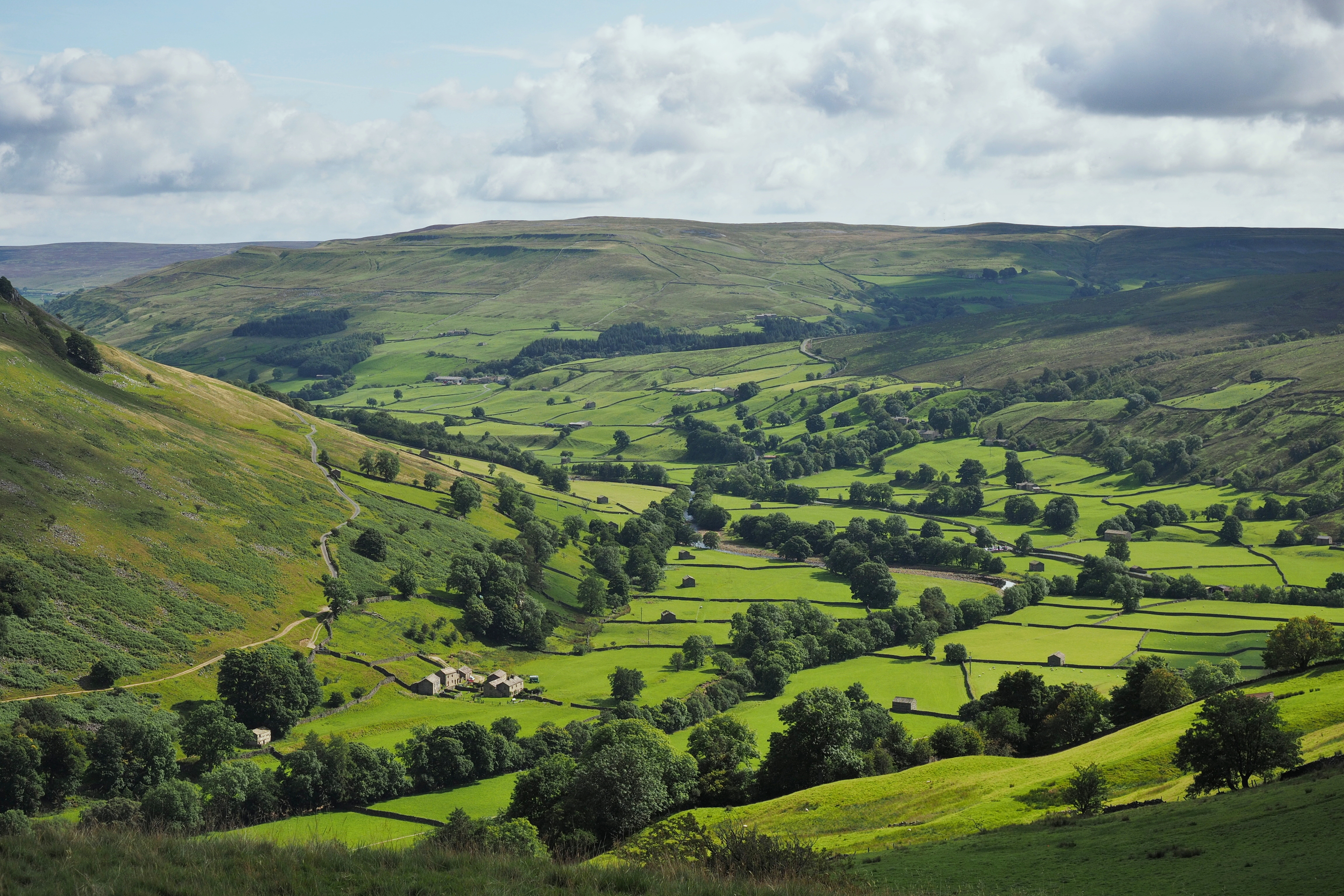|
Fremington, North Yorkshire
Fremington is a hamlet in the Yorkshire Dales in North Yorkshire, England. The hamlet is almost joined to Reeth and Grinton. It is split into Low Fremington which is built along the B6270 and High Fremington which is a scattering of houses running up towards Fremington Edge. The origin of the place-name is from the Old English words ''Fremi'' (or ''Frema''), ''ing'' and ''tun'' and means estate associated with a man named Fremi (or Frema). It appears as ''Fremington'' in the Domesday Book of 1086. In the 19th-century a hoard of 1st-century Roman horse harness fittings, known as the Fremington Hagg Hoard The Fremington Hagg Hoard is a hoard A hoard or "wealth deposit" is an archaeological term for a collection of valuable objects or artifacts, sometimes purposely buried in the ground, in which case it is sometimes also known as a cache. T ..., was found near Fremington. References External links Villages in North Yorkshire Swaledale {{richmondshire- ... [...More Info...] [...Related Items...] OR: [Wikipedia] [Google] [Baidu] |
Richmondshire
{{Infobox settlement , name = Richmondshire District , type = District , image_skyline = , imagesize = , image_caption = , image_blank_emblem= Richmondshire arms.png , blank_emblem_type = Coat of arms , image_map = Richmondshire UK locator map.svg , map_caption = Shown within North Yorkshire , mapsize = frameless , subdivision_type = Sovereign state , subdivision_name = United Kingdom , subdivision_type1 = Constituent country , subdivision_name1 = England , subdivision_type2 = Region , subdivision_name2 = Yorkshire and the Humber , subdivision_type3 = Administrative county , subdivision_name3 = North Yorkshire , seat_type = Admin. HQ , seat = Richmond , government_type = Richmondshire District Council , leader_title = Leadership: , leader_name = Alternative – Sec.31 , leader_title1 = Executive: , leader_name1 = {{English district cont ... [...More Info...] [...Related Items...] OR: [Wikipedia] [Google] [Baidu] |
North Yorkshire
North Yorkshire is the largest ceremonial county (lieutenancy area) in England, covering an area of . Around 40% of the county is covered by national parks, including most of the Yorkshire Dales and the North York Moors. It is one of four counties in England to hold the name Yorkshire; the three other counties are the East Riding of Yorkshire, South Yorkshire and West Yorkshire. North Yorkshire may also refer to a non-metropolitan county, which covers most of the ceremonial county's area () and population (a mid-2016 estimate by the ONS of 602,300), and is administered by North Yorkshire County Council. The non-metropolitan county does not include four areas of the ceremonial county: the City of York, Middlesbrough, Redcar and Cleveland and the southern part of the Borough of Stockton-on-Tees, which are all administered by unitary authorities. The non-metropolitan county and the City of York are within the Yorkshire and the Humber region. Middlesbrough, Redcar ... [...More Info...] [...Related Items...] OR: [Wikipedia] [Google] [Baidu] |
Fremington Mill, North Yorkshire , England
{{geodis ...
Fremington can refer to: *Fremington, Devon, England *Fremington, North Yorkshire Fremington is a hamlet in the Yorkshire Dales in North Yorkshire, England. The hamlet is almost joined to Reeth and Grinton. It is split into Low Fremington which is built along the B6270 and High Fremington which is a scattering of houses run ... [...More Info...] [...Related Items...] OR: [Wikipedia] [Google] [Baidu] |
Yorkshire Dales
The Yorkshire Dales is an upland area of the Pennines in the historic county of Yorkshire, England, most of it in the Yorkshire Dales National Park created in 1954. The Dales comprise river valleys and the hills rising from the Vale of York westwards to the hilltops of the Pennine watershed. In Ribblesdale, Dentdale and Garsdale, the area extends westwards across the watershed, but most of the valleys drain eastwards to the Vale of York, into the Ouse and the Humber. The extensive limestone cave systems are a major area for caving in the UK and numerous walking trails run through the hills and dales. Etymology The word ''dale'', like ''dell'', is derived from the Old English word ''dæl''. It has cognates in the Nordic/ Germanic words for valley (''dal'', ''tal''), and occurs in valley names across Yorkshire and Northern England. Usage here may have been reinforced by Nordic languages during the time of the Danelaw. Most of the dales are named after their river or stre ... [...More Info...] [...Related Items...] OR: [Wikipedia] [Google] [Baidu] |
Reeth
Reeth is a village west of Richmond in the Richmondshire district of North Yorkshire, England, in the civil parish of Reeth, Fremington and Healaugh. Historically part of the North Riding of Yorkshire, it is the principal settlement of upper Swaledale. Etymology The origin of the name ''Reeth'' is unclear. It is possibly derived from the Germanic for 'place by the stream', although this claim can neither be confirmed nor refuted. Reeth could also have been derived from the Cumbric ''rith'' (cf. ''ryd'' in Modern Welsh, ''rys'' in Cornish ), meaning 'Ford'. Either would make sense as Reeth is located near two shallow rivers. History In Saxon times, Reeth was only a settlement on the forest edge, but by the time of the Norman conquest it had grown sufficiently in importance to be noted in the ''Domesday Book''. Later it became a centre for hand-knitting and the local lead industry was controlled from here, but it was always a market centre for the local farming community ... [...More Info...] [...Related Items...] OR: [Wikipedia] [Google] [Baidu] |
Grinton
Grinton is a small village and civil parish in the Yorkshire Dales, in the Richmondshire district of North Yorkshire, England. Close to Reeth and Fremington, it lies west of Richmond on the B6270 road. On 5 July 2014, the Tour de France Stage 1 from Leeds to Harrogate passed through the village. The route would have been repeated, if not for the changing of the route due to high rainfall, in the Men's road race in the 2019 UCI World Championships going through the climb ''Grinton moor'', which lasted for at an average gradient of 7%. St Andrew's church Often called "The Cathedral of the Dales", Grinton church is dedicated to St Andrew and was for centuries the main church for the whole of upper Swaledale, with many burials coming from miles away. The bodies were carried as much as 16 miles down the valley along the footpath from Keld, now known as the Corpse Way or corpse road, in wicker coffins. Several long stones, located at intervals along the path, traditionally calle ... [...More Info...] [...Related Items...] OR: [Wikipedia] [Google] [Baidu] |
Fremington Edge
Fremington Edge is a long wall of crags and scree slopes that is situated to the north of the village of Reeth in Swaledale in the Yorkshire Dales, Yorkshire Dales National Park, England. Fremington Edge forms the south-eastern edge of Arkengarthdale, extending to the point where the dale meets Swaledale. Throughout its full length the Edge stays above the height of and reaches a highest point of at the northern end of the escarpment. History Fremington Edge was formed after the last Ice age when melt water from the retreating glaciers caused a landslip and exposed the rocky outcrops. Evidence of an Iron Age fort on the escarpment, and a settlement pre-date the 8th century arrival of the Anglo-Saxons. The Edge is scattered with remains of old lead and chert mines, and there are many disused shafts and spoil heaps. The chert was taken by lorry to Staffordshire for use in producing china and porcelain. A footpath and a solid Dry-stone wall, dry stone wall stretch the entire le ... [...More Info...] [...Related Items...] OR: [Wikipedia] [Google] [Baidu] |
Old English
Old English (, ), or Anglo-Saxon, is the earliest recorded form of the English language, spoken in England and southern and eastern Scotland in the early Middle Ages In the history of Europe, the Middle Ages or medieval period lasted approximately from the late 5th to the late 15th centuries, similar to the post-classical period of global history. It began with the fall of the Western Roman Empire .... It was brought to Great Britain by Anglo-Saxon settlement of Britain, Anglo-Saxon settlers in the mid-5th century, and the first Old English literature, Old English literary works date from the mid-7th century. After the Norman conquest of 1066, English was replaced, for a time, by Anglo-Norman language, Anglo-Norman (a langues d'oïl, relative of French) as the language of the upper classes. This is regarded as marking the end of the Old English era, since during this period the English language was heavily influenced by Anglo-Norman, developing into a phase know ... [...More Info...] [...Related Items...] OR: [Wikipedia] [Google] [Baidu] |
Domesday Book
Domesday Book () – the Middle English spelling of "Doomsday Book" – is a manuscript record of the "Great Survey" of much of England and parts of Wales completed in 1086 by order of King William I, known as William the Conqueror. The manuscript was originally known by the Latin name ''Liber de Wintonia'', meaning "Book of Winchester", where it was originally kept in the royal treasury. The '' Anglo-Saxon Chronicle'' states that in 1085 the king sent his agents to survey every shire in England, to list his holdings and dues owed to him. Written in Medieval Latin, it was highly abbreviated and included some vernacular native terms without Latin equivalents. The survey's main purpose was to record the annual value of every piece of landed property to its lord, and the resources in land, manpower, and livestock from which the value derived. The name "Domesday Book" came into use in the 12th century. Richard FitzNeal wrote in the '' Dialogus de Scaccario'' ( 1179) that the bo ... [...More Info...] [...Related Items...] OR: [Wikipedia] [Google] [Baidu] |
Fremington Hagg Hoard
The Fremington Hagg Hoard is a hoard A hoard or "wealth deposit" is an archaeological term for a collection of valuable objects or artifacts, sometimes purposely buried in the ground, in which case it is sometimes also known as a cache. This would usually be with the intention of ... of Roman horse harness fittings found in Fremington Hagg, near Reeth, North Yorkshire in the early 19th Century. Parts of it are in the collections of the British Museum and the Yorkshire Museum. Discovery The hoard was discovered before 1833, when the first objects were donated to the Yorkshire Museum. Other items were donated to the Museum by Captain Harland in 1852. In 1880 A. W. Franks donated a portion of the hoard to the British Museum. Contents There are seven pieces in the British Museum and 68 pieces in the Yorkshire Museum which, together, probably constituted the original hoard. These are all harness fittings (horse gear) - decorative elements used on reigns and other straps. A ... [...More Info...] [...Related Items...] OR: [Wikipedia] [Google] [Baidu] |
Villages In North Yorkshire
A village is a clustered human settlement or community, larger than a hamlet but smaller than a town (although the word is often used to describe both hamlets and smaller towns), with a population typically ranging from a few hundred to a few thousand. Though villages are often located in rural areas, the term urban village is also applied to certain urban neighborhoods. Villages are normally permanent, with fixed dwellings; however, transient villages can occur. Further, the dwellings of a village are fairly close to one another, not scattered broadly over the landscape, as a dispersed settlement. In the past, villages were a usual form of community for societies that practice subsistence agriculture, and also for some non-agricultural societies. In Great Britain, a hamlet earned the right to be called a village when it built a church. [...More Info...] [...Related Items...] OR: [Wikipedia] [Google] [Baidu] |







